Tick Identification Guide
Tick Species Identification
Of the hundreds of tick species in existence, humans contract most tick-borne diseases from just three types of tick: blacklegged ticks, dog ticks, and lone star ticks. Select a tick image or name to learn more about each species.
The Tick Research Lab of Pennsylvania can test each of these tick species for common pathogens. Our tick DNA tests are 99.9% accurate.
We can also attempt to identify photos of your tick as a free courtesy service.
Ticks are found all over North America. Of the hundreds of tick species, many live in the wilderness, feeding only on animals. Some of the more common species inhabit the same areas as humans, feeding on people and pets.
Species that pose a threat to humans and pets include the deer tick (a blacklegged tick), the Western blacklegged tick, the American dog tick, the brown dog tick, and the lone star tick. While these species share many traits and behaviors, each is capable of carrying different pathogens.
Knowing about the ticks in your area and their life stages will help you protect yourself, your family, and your pets from dangerous tick-borne diseases. The information on this page can help you identify ticks that may be a threat to your health.
The tick life cycle consists of four stages. Tick adults lay eggs. Newly-hatched ticks, known as larvae, grow into nymphs and later become adult ticks. Larvae, nymphs, and adult females all feed on blood. If a host is infected with a tick-borne disease, it can infect the tick, which may pass the disease to its next host.
Swipe to browse ticks

Deer Tick
(Eastern blacklegged Tick)
Although it’s one of North America’s most common ticks, the deer tick is hard to spot thanks to its small size. (It’s about the same size as a sesame seed.) This tick is identifiable by its reddish-brown color and the black shield on its back. It uses narrow mouth parts in feeding. The deer tick is also known as the blacklegged tick.
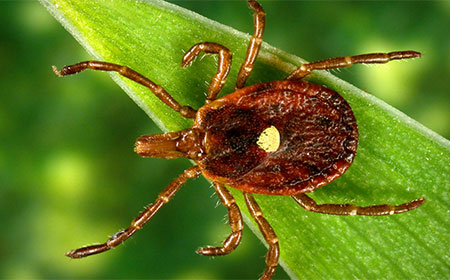
Lone Star Tick
The lone star tick is a reddish-brown color with festoons along the outer portion of their body. Adult females have a white spot (a “lone star”) on the dorsal shield. Adults are around 3mm long.
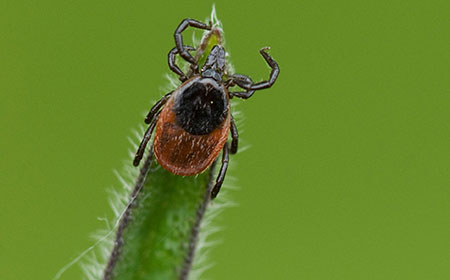
Western Blacklegged Tick
The western blacklegged tick is similar to the deer tick, although its body has more of an oval shape. These ticks are found on the West Coast and in some other areas in the western US.
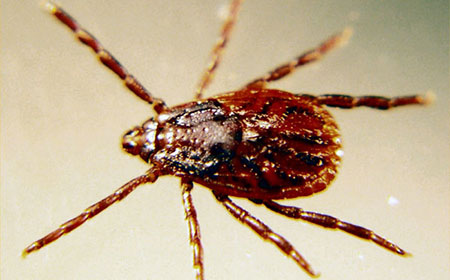
Brown Dog Tick
The brown dog tick is known for its long, small body and bluntly shaped mouth parts. It lacks a distinct dorsal shield. It gets its name because it generally feeds on dogs, but it also bites humans.
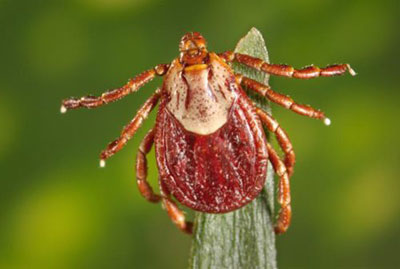
Rocky Mountain Wood Tick
Adult ticks feed primarily on large mammals. Larvae and nymphs feed on small rodents. Adult ticks are primarily associated with pathogen transmission to humans.
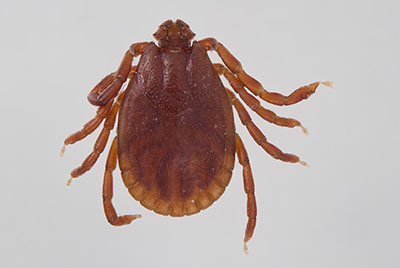
Asian Longhorned Tick
The Asian longhorned tick (Haemaphysalis longicornis) has recently been discovered in the United States. It is typically found in China, Japan, Korea and other Asian countries.
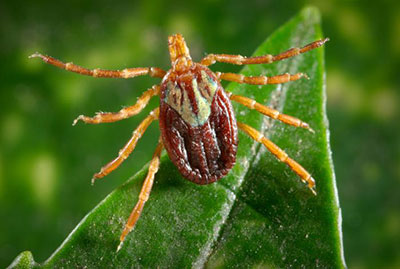
Gulf Coast Tick
Larvae and nymphs feed on birds and small rodents, while adult ticks feed on deer and other wildlife. Adult ticks have been associated with transmission of R. parkeri to humans.
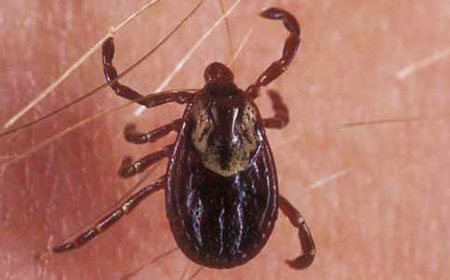
American Dog Tick
The biggest of North America’s common ticks, the American dog tick is brown with pointed mouth parts. Its dorsal shield features white markings near the tick’s head. The American dog tick is known for biting dogs, but it also feeds on humans.
Identifying Tick Life Stages
Larval Stage
The larval stage is the first stage after a tick hatches. Larvae have six legs. Identification can be difficult, but a professional can determine the species using a microscope. Even larval ticks can spread certain pathogens.
Nymph Stage
Tick nymphs have 8-legs like adults and can be as small as a poppy seed. A nymph has a pale abdomen and a dorsal shield covering its back. Ticks at this stage may be difficult to identify with the naked eye but can be identified in a lab or by an expert.
Adult Stage
Each species has identifying features that are most distinguishable in the adult stage. They can be identified based on the festoons on the edge of the abdominal area, the appearance of the dorsal shield, and the shape of the mouth parts. Size can also be used in identification.
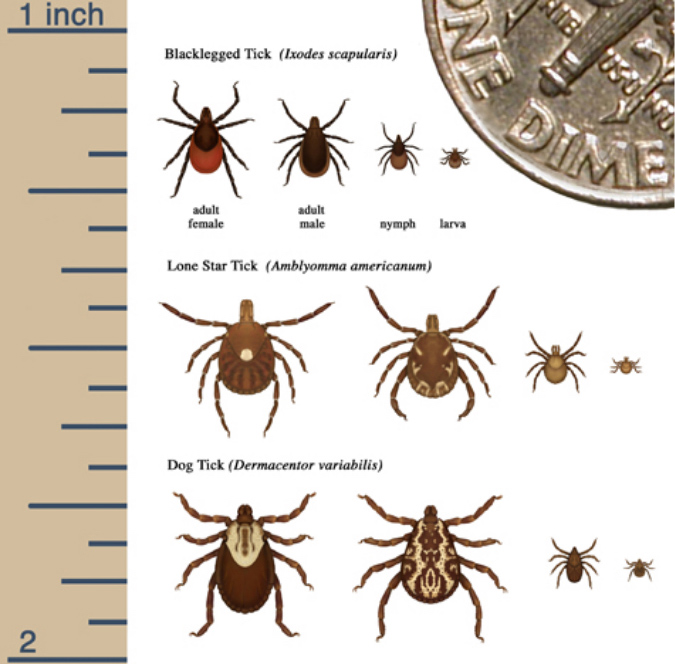
Parts of a Tick
- Hypostome Mouth part used to take in blood. The hypostome is inserted into the host for feeding. Adult male ticks fertilize females via the hypostome.
- Palp Alerts a tick to the presence of a potential host.
- Porose Area The porose area can be used to identify adult female deer ticks, which have a smaller porose area than other types of tick.
- Scutum/Shield The shield can help in identifying a tick’s life phase, sex, and species. All deer ticks have oblong shields. In deer ticks, nymphs and adult females have shields covering only part of the body. A male’s shield covers the entire body.
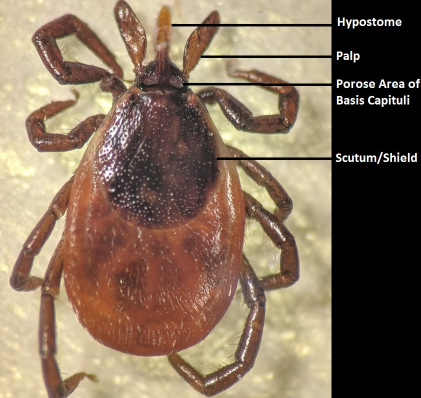
- Trochanter Part of a tick’s leg. The trochanter, which attaches to the coxa, can be used in species identification. In deer ticks, the trochanter does not have spurs.
- Basis Capituli Connects the mouth parts and the body. In deer ticks, the basis capituli is straight where it meets the tick’s body and does not have humps near the hypostome.
- Coxa I-IV Body part that connects the tick’s body and the leg trochanter.
- Genital Aperture The part of the adult female that accepts the male’s hypostome for fertilization.
- Spiracular Plate Holds glands for moisture retention and air distribution. Can be used to identify a tick’s species.
- Anal Groove A mark near the anus that can be used in species identification. The anal groove is located above the anus in deer ticks. It can be found below the anus in other species.
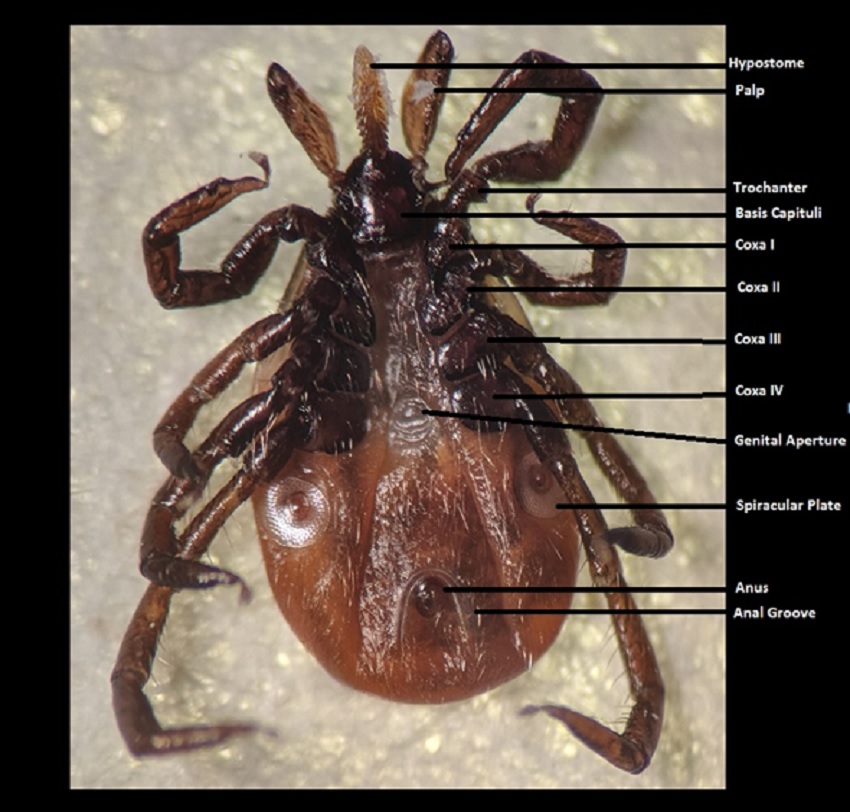
Knowing whether a tick is male or female can help determine whether it is a threat to humans. Male ticks sometimes attach to hosts but do not transmit disease because they do not feed on blood. A tick that has become engorged is certainly female, and any tick that has attached to a host is most likely female.
Checking the dorsal shield is a reliable way to determine whether a tick is male or female. In male ticks, the dorsal shield covers most of the body. In female ticks, the dorsal shield covers only part of the body. This is true for all species of tick.


